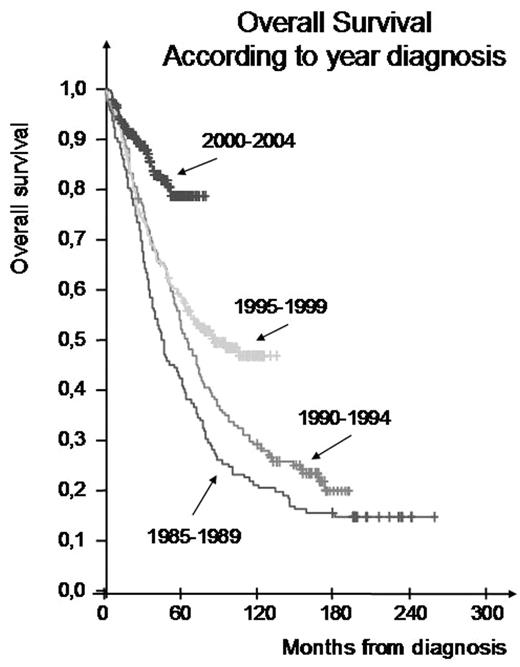Abstract
Purpose: To assess the incidence of chronic myeloid leukemia (CML) in the Nord-Pas de Calais Region in Northern France (~ 4 millions inhabitants) and to describe the patients (pts) characteristics and evolution.
Methods: A retrospective study was conducted to record all confirmed diagnosis of CML that occurred during the period 1985–2004. All pts were actually living in the region at the diagnosis. CML was diagnosed by cytogenetic and molecular tests (Philadelphia chromosome and/or BCR-ABL fusion gene). Pts were screened through the results of the two cytogenetic and molecular laboratories of the region. The possibility of pts diagnosed outside the region is negligible and under study. Age-standardized incidence rate calculation was based on the standard world population.
Results: 783 pts with confirmed diagnosis of CML were included. Age-standardized incidence rate is 0.82/100,000 people during the 1990–2004 period, with a raw incidence rate of 1.02/100,000 people during the same period. In the whole 20 years cohort, 55.7% of the pts are of male gender and the median age at diagnosis is 55.3 years (5.4–93.4). Haematological status at diagnosis was available for 83.5% of pts: chronic phase (CP) for 623 pts (95.3%), accelerated phase (AP) for 21 pts (3.2%), and blastic crisis (BC) for 10 pts (1.5%). Sokal index was available for 67% of pts, and was low for 40.5%, intermediate for 35.9%, and high for 23.6% of them. At December 31th 2004, 331 (42.3%) pts were still alive, 370 (47.2%) were deceased and 82 (10.5%) of unknown status. Taking into account the patients who have left the region, the raw prevalence rate is 8.1/100,000 people at this date. During the follow-up, an advanced phase was documented for 206 pts (26.5%) of the whole cohort and 189 (48.5%) of deceased patients. Allogeneic bone marrow transplantation was performed in 140 (17.9%) pts with a 5-years overall survival rate of 60%. 354 pts (45.2%) received interferon alfa (IFN) (median treatment duration 13.5 Mo (0.5–157.1)) with 24.6% pts achieving a major cytogenetic response (MCyR). 302 pts (38.6%) were treated by imatinib mesylate (IM) (median treatment duration 31.3 Mo (0.5–72.3)) with a rate of MCyR of 75.2% for pts in CP at IM initiation (206 informative pts). The overall median survival of the whole cohort was 72 months. For the diagnosis periods 1985–1989, 1990–1994, 1995–1999, and 2000–2004, the 5-years overall survival rates were respectively 41.6%, 51%, 57.5%, and 78.5% (p<0.0001).
Conclusion: our findings in a well defined region corroborate the results of other cancer registries for the CML incidence. The prognosis of this disease has been modified by bone marrow transplantation and the use of interferon alfa but the major survival improvement seems related to the large use of tyrosine kinase inhibitors since 2000–2001, suggesting a great increase of CML prevalence in the future.
Overall Survival According to year diagnosis
Disclosure: No relevant conflicts of interest to declare.
Author notes
Corresponding author


This feature is available to Subscribers Only
Sign In or Create an Account Close Modal